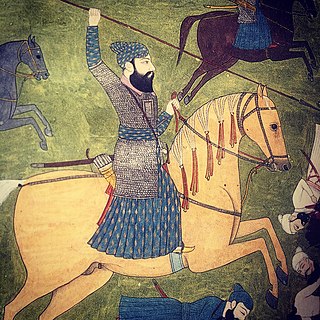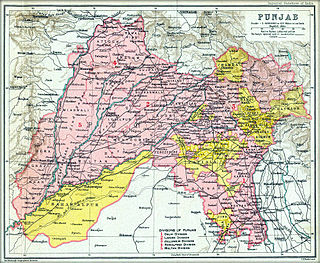
Shah Alam II, also known by his birth name Ali Gohar, or Ali Gauhar, was the seventeenth Mughal emperor and the son of Alamgir II. Shah Alam II became the emperor of a crumbling Mughal Empire. His power was so depleted during his reign that it led to a saying in the Persian language, Sultanat-e-Shah Alam, Az Dilli ta Palam, meaning, 'The empire of Shah Alam is from Delhi to Palam', Palam being a suburb of Delhi.

Dal Khalsa was the name of the combined military forces of 11 Sikh misls that operated in the 18th century (1748–1799) in the Punjab region. It was established by Nawab Kapur Singh in late 1740s.
Guru Nanak founded the Sikh religion in the Punjab region of the northern part of the Indian subcontinent in the 15th century and opposed many traditional practices like fasting, janeu, idolatry, caste system, ascetism, azan, economic materialism, and gender discrimination.

Baghel Singh was a Military general in the Punjab region in the northern part of the Indian subcontinent in the 18th century. He rose to prominence in the area around Sutlej and Yamuna. Singh joined the Singh Krora Misl, one of the misls during Sikh Confederacy. In 1765, Singh became the leader of the misl.

Sirhind is the older name of Fatehgarh Sahib, a city and Sikh pilgrimage site in Punjab, India. It is situated on the Delhi to Lahore Highway. It has a population of about 60,851 . It is now a district headquarters in the state of Punjab; the name of the district is Fatehgarh Sahib.

The Sikh Rule in Lahore initiated from the conquest and rule of the Sikh Misls and extended till the Sikh Empire of Ranjit Singh which ended in 1849. The Sikhs began gaining power following the decline of the Mughal Empire in Punjab and consisted of a collection of autonomous Punjabi Misls, which were governed by Misldars, mainly in the Punjab region.

Banda Singh Bahadur, was a Sikh warrior and a general of the Khalsa Army. At age 15, he left home to become an ascetic, and was given the name Madho Das Bairagi. He established a monastery at Nānded, on the bank of the river Godāvarī. In 1707, Guru Gobind Singh accepted an invitation to meet Mughal Emperor Bahadur Shah I in southern India, he visited Banda Singh Bahadur in 1708. Banda became disciple of Guru Gobind Singh and was given a new name, Gurbaksh Singh(as written in Mahan Kosh), after the baptism ceremony. He is popularly known as Banda Singh Bahadur. He was given five arrows by the Guru as a blessing for the battles ahead. He came to Khanda, Sonipat and assembled a fighting force and led the struggle against the Mughal Empire.
Lohgarh is a historic town in Bilaspur tehsil of Yamunanagar district of Haryana in India. It was the capital of First Sikh State under Baba Banda Singh Bahadur from 1710 to 1716.

Binod Singh, a Trehan Khatri and a descendant of Guru Angad, was an army man and disciple of Guru Gobind Singh and was among few Sikhs who accompanied him to Nanded in 1706. In Budha Dal Chronicles, Guru Gobind Singh made Baba Binod Singh the head of the Khalsa.

The State of Malerkotla or Maler Kotla was established by Maharaja of Parmar Rajputs, is a princely state in the Punjab region since the era of British India. Which was taken over by Sarwani and Lodi Pashtun dynasty from Afghanistan, and named Malerkotla as capital.
The siege of Sirhind was fought between the Mughal Empire and Sikh forces in 1710. The Sikhs besieged, stormed, captured, plundered and razed the city of Sirhind after defeating and beheading Wazir Khan in the Battle of Chappar Chiri.

Ahmad Shah Durrani, the founder of the Durrani Empire, invaded Indian subcontinent for eight times between 1748 and 1767, following the collapse of Mughal Empire in the mid-18th century. His objectives were met through the raids and deepened the political crisis in India.

The Battle of Chappar Chiri, also called Battle of Sirhind, was fought between Mughal Empire and the Sikhs on 12 May 1710 at Chappar Chiri, located 20 kilometers from Sirhind.

The Battle of Rahon was fought between Sikhs and Mughal Empire on 11 October 1710.

Fateh Singh was a warrior in Sikh history. He is known for beheading Wazir Khan who was the Mughal Governor of Sirhind, administering a territory of the Mughal Empire between the Sutlej and Yamuna rivers. Wazir Khan was infamous for ordering the execution of the two young sons of Guru Gobind Singh, Sahibzada Fateh Singh and Sahibzada Zorawar Singh in 1704.
Sikh attacks on Delhi were common in the second half of the 18th century. The Sikhs attacked Delhi 19 times between 1766 and 1788.

The Khalsa Fauj were the military forces of the Khalsa order of the Sikhs, established by the tenth guru, Guru Gobind Singh, in 1699. It replaced the Akal Sena that had been established by the sixth guru, Guru Hargobind.

The siege of Ram Rauni was a 4 months siege fought between the Sikh forces led by Jassa Singh Ahluwalia and the Mughal forces of Adina Beg, Dewan Kaura Mal, Mirza Aziz Khan and Bakhshi Nasir Ali Khan Jalandri.
The Raid of Panipat (1770) was a raid on 4 January 1770 by the Sikh forces led by Jassa Singh Ahluwalia against the Mughal forces led by Zabita Khan.

The First Sikh State was a breakaway and short lived sovereign Sikh state during the 18th century in the Punjab region of the Indian subcontinent that existed from 1709 to 1715. It was established by Banda Singh Bahadur after the Battle of Samana and lasted until his defeat in the Battle of Gurdas Nangal.














